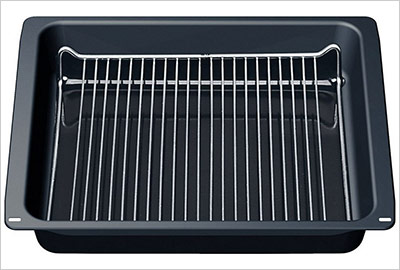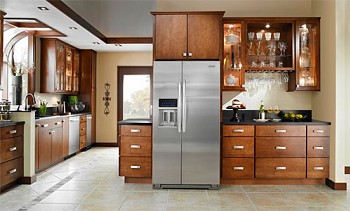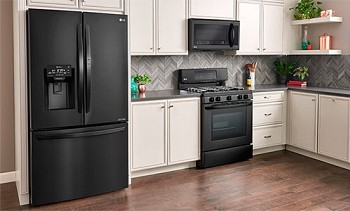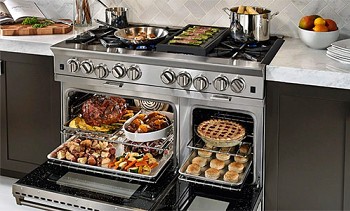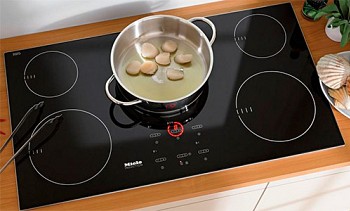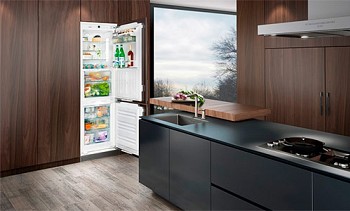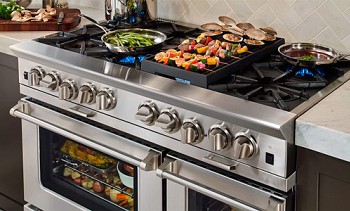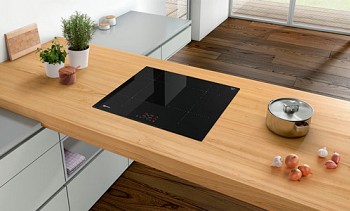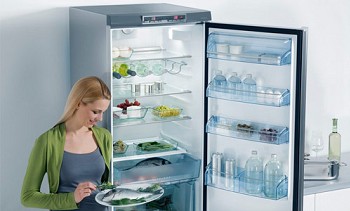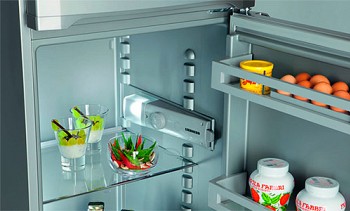To be able to please yourself and loved ones with delicious dishes as often as possible, just a cooking talent is not enough, you also need to selectively select kitchen equipment. And first of all we are talking about an oven, because, as a rule, it is in it that real culinary masterpieces are created.
The range of ovens available on the market today is astounding and puts you in a state of confusion and confusion. How to choose the built-in electric oven to not just spend money, but to get a real assistant in the kitchen? The task is difficult, but quite solvable ...
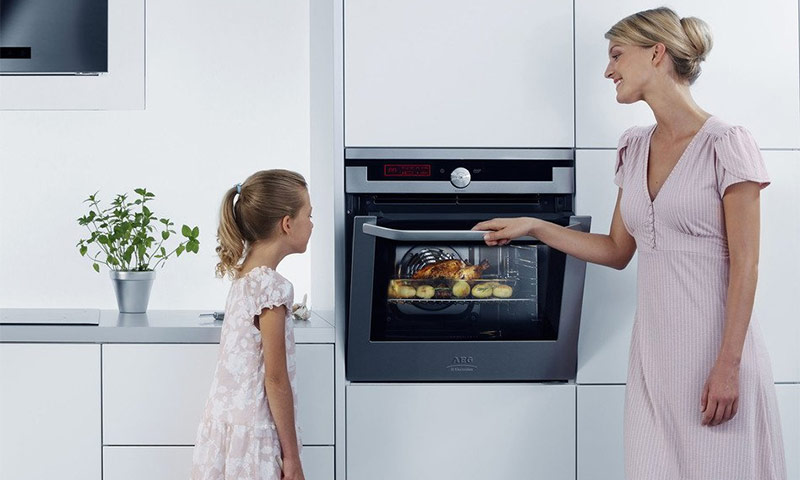
Content:
We choose the type of execution - independent and dependent built-in ovens
Most ovens manufactured today are independent appliances. They have their own control system, and their work is in no way connected with the work of other kitchen units. For many users, this is a huge advantage, because such an oven can be placed anywhere in the kitchen (for example, in a cabinet-column for built-in appliances) at the height that is most convenient for you.

There is an alternative option - a dependent oven. A similar one is sold complete with a hob and has a common control panel with it located on the front surface of the oven. If you initially plan to buy one and the other kitchen unit, then the purchase of such a set is a real chance for you to save, because it will cost you much cheaper than the oven and hob, purchased separately. In addition, the elements of the kit are usually made in the same style, which means that you do not have to keep in mind the question of the compatibility of equipment among themselves in design.

Some manufacturers leave the buyer with the choice of releasing several models of hob compatible with this model of the oven. On this, the advantages of dependent ovens end, followed by, alas, a number of minuses.
- Firstly, the combined control panel often looks somewhat overloaded with control elements.
- Secondly, there are restrictions on the placement of the oven: the hob and oven must be located in close proximity to each other, and since the first is always installed at a certain level, you can inevitably get access to the second only by bending down.
- The third and most significant drawback of dependent sets is that if for some reason your oven breaks down, you are very likely to lose the ability to use the hob.
Oven dimensions and installation rules
There are several sizes of ovens. Both the width and the height of the full-size (standard) oven are 60 cm. Compact with the same width a little lower - 40-45 cm, and narrow, on the contrary, with a standard height they have a smaller width - only 45 cm. Compact and especially narrow ovens - Ideal for small kitchens. There are models on the market with a width increased to 90 cm, their height, like that of compact ovens, is 45 cm.The depth of all the above types of ovens is approximately the same - 55-60 cm, because this parameter is determined by the depth of the kitchen set, and here there is a standard dictated by the question of convenience.

The answer to the question of which built-in electric oven is better to choose, primarily depends on the size of the room that you have. Most of our compatriots are still owners of incredibly tiny kitchens, where the struggle is for every free centimeter of space. And since you also want to equip such a kitchen with all the necessary equipment, you have to sacrifice something, in this case, the size of the oven. However, this will not necessarily be a sacrifice: if you have a small family and, therefore, you cook a little, then there is simply no need to chase a large model.
We consider it necessary to warn you against one rather common mistake. If, having read the mounting dimensions on the price list of the model you like, you will gladly rub your hands at the thought that you can squeeze this oven into the niche reserved for it, we hasten to disappoint you - this oven is not suitable for you, and you need to look for another option. The word “squeeze” is not acceptable for embedded technology. The oven is a powerful source of heat, which means that furniture that is in close contact with its walls will also heat up. Regular overheating of the latter will inevitably become the cause of gradual destruction (the worst outcome is not excluded - ignition). Therefore, when embedding heating equipment in furniture, ventilation gaps between their walls should be provided.
The distance between the oven and the side walls of the niche into which it will be built-in must be at least 5 mm on each side, and from the bottom of the oven to the "floor" of the niche - at least 85 mm. The back walls should be separated by at least 40 mm of free space (often the back wall of the niche is simply removed).

The numbers above are some general guidelines. Different models may have their own installation features, and you should focus primarily on the information contained in the instruction manual.
Oven Cleaning Methods
Many people like to create various culinary masterpieces in ovens, almost everyone loves to absorb these freshly baked dishes, but no one is eager to wash the walls of the oven splattered with fat. Modern technologies can significantly facilitate this process, but the ovens in which these technologies are implemented are much more expensive. Oven with which cleaning method to choose and whether it is worth paying for it at all?
Traditional.
Inexpensive models, the inner walls of which are coated with ordinary heat-resistant enamel, require traditional cleaning - by hand, using a sponge and detergent.
It should be noted that if you do not accumulate dirt for years, and clean it regularly, after each cooking, then it is not so difficult.

Catalytic.
Most mid-priced models have a catalytic purification method. The walls of the working chamber in such ovens (often not all, but only the back, as the most contaminated) are coated with special enamel containing a catalyst. The latter promotes the breakdown of fat into water and carbon, this occurs at elevated temperatures, directly in the cooking process. When the oven cools down, it remains to remove the soot accumulated as a result of the catalytic process with a damp sponge. The disadvantage of this method is the decrease in catalyst activity after 5-7 years of active use of the oven.

Pyrolytic.
In premium models, a more effective cleaning method is often used - pyrolytic. When activated, the oven heats up to 500 ° C, at such a high temperature the fat simply burns out.After such self-cleaning, it is enough to wipe the walls of the oven with a damp cloth or sponge to remove a small amount of the pyrolysis product - soot. This method contributes to additional energy consumption, and the ovens in which it is implemented are the most expensive, but despite this, pyrolysis is very popular among consumers.

Steam and water.
In recent years, another cleaning method has gained popularity - steam and water. It is quite simple and economical, but at the same time quite effective. A baking sheet with a small amount of water is installed in the oven and the cleaning mode is activated. Steam generated as a result of heating the liquid softens the contaminants on the walls of the working chamber, and they are easily removed mechanically. Even the owners of the cheapest ovens can use this method, because in order to start the process of steam formation, it is not at all necessary to have a special button on the control panel - just warm up the working chamber to 70-90 ° С.

Control system selection
The convenience of using the oven is largely determined by the way its control system is implemented. Two options are possible here - electromechanical and electronic control.
The presence of an electromechanical control unit significantly reduces the cost of the unit, but still its main advantage is simplicity. Even if you are not limited in means, but you acquire equipment for one of your elderly relatives, when deciding which built-in electric oven to choose, with electromechanical control or electronic, preference should be given first: older people, as a rule, have difficulty with communicating with modern electronics.
The electromechanical control unit is represented by three rotary switches familiar to everyone: one is used to set the temperature, the second - a timer - is necessary to control the operation time of the oven, using the third one the heating mode is selected. Sometimes rotary switches are made recessed into the device body, but this does not introduce any fundamental changes in their functioning, but only simplifies the process of cleaning the panel from dirt.

In electronically controlled ovens, all necessary operating parameters are set using buttons or, more often, touch fields. Typically, electronic control provides for a special display that displays information about the selected mode, temperature, cooking time, etc.
Today you can find models with fairly large touch color displays. The latter do not just display information about the operation of the oven, but visualize the process of "communication" of the user with it. The management of such a technique resembles the management of modern digital gadgets - with “turning over” the menu pages, selecting the necessary items by touching the corresponding icons on the display, etc. If you belong to the category of people who are ready for any expenses for the sake of owning the most “advanced” technology, you can even look for an oven that allows you to download various data, including recipes and photos of ready-made dishes via USB port - today there are such .

The electronic control system does not just expand the capabilities of the oven, allowing you to implement various automatic cycles, set the on or off time, more precisely control the time and temperature. It provides a different level of convenience in using household appliances. But electronics, in addition to high cost, has another significant drawback - the probability of its failure is much higher than that of electromechanics.
We determine the culinary functionality
Most modern ovens are multifunctional devices. What your oven knows how to do depends on how much you can realize your culinary potential.
Heating modes
The preparation of different products requires different temperatures and different heating rates. It follows that the more heating modes the oven has, the more varied the list of dishes that you can cook in it, the more opportunities you will have for various culinary experiments. Low-cost electric ovens, as a rule, have an upper, lower and combined (upper + lower) heating, as well as a grill mode.

In more expensive models, convection is added to the classic heating modes. On the back wall of such ovens there is a fan around which an annular heating element is placed. The fan contributes to the rapid and uniform distribution of heated air throughout the working chamber.

Additional modes
Ovens with electronic controls often have a number of additional modes that significantly expand the functionality of the device. The presence of a convection fan allows you to implement a mode of gentle defrosting of products: the heating elements in this mode do not turn on, and the fan drives room temperature air through the chamber. The “Stewing” and “Stewing” programs are designed for slow cooking of products at relatively low temperatures, which contributes to the maximum preservation of useful substances in them. The “Fermentation” mode can be used for cooking yogurt at home, raising yeast dough, etc.
Steamer function
Some modern oven models have a steam mode. In most cases, this is not steaming, namely the symbiosis of steam and heat treatment of products. However, on sale there are ovens with a special design of the steam generator - these can be used as classic double boiler.
Microwave module
An electric oven can be equipped with an integrated microwave module. As a result, you get two appliances in one, which can be used both as an oven and as a microwave. Moreover, if you wish, you can combine conventional heating with microwave, which can significantly reduce the cooking time.
Automatic programs
Significantly simplify the process of preparing various dishes will help automatic programs built into the memory of an electronic oven. It is enough for the user to indicate the type of product (meat, fish, vegetables, etc.), choose one of the types of dishes offered to him that can be prepared from this product, enter the weight of the product. Further, the oven acts on its own: being guided by the algorithms stored in her memory, she chooses the temperature regime and determines the time of the process, and after some time you get a ready dinner. The number of pre-installed automatic programs for different models is different, but can reach several tens. Some modern premium ovens allow the user to update software by downloading new auto programs in addition to existing ones, as well as save their own cooking algorithms.
Skewer
If you often bake whole carcasses of poultry or large pieces of meat as the main course of a gala dinner, you can use a skewer. A skewer rotating from a specially designed electric drive will help you evenly warm up the product, make your crown dish even more tasty and attractive.

However, if your oven has a convection heating mode, then you can refuse the grill. The fan will also do its job perfectly: in this case, it’s not the products that rotate in hot air, but the hot air around the products - the effect will be the same, which means that the meat on the grill will cook no worse than on the skewer.
Thermal probe
When baking large pieces of meat, it can be difficult to assess how much the temperature inside the piece differs from the air temperature in the working chamber, and therefore make an assumption about the degree of readiness of the product.A thermometer will come to your aid - a thermometer that measures the temperature inside the prepared product. When the required temperature is reached, the thermal probe will “notify” the control system about this, and that in turn will notify the user about this or perform an automatic shutdown.

Oven door
The doors of most ovens open in the traditional way, leaning forward. This is not always convenient (especially in small kitchens), but we are all so used to it that we can not imagine otherwise.

However, other options also exist. If the oven is not installed under the hob, but at the user's chest level, then a model with a hinged door that opens left or right is more suitable.

Ovens with sliding doors are also found: baking sheets in this case are fixed on the door and are advanced with it. Thanks to this design, you do not have to poke your hands in a hot oven. All the prepared dishes can be rolled out and well considered.

It should be said a few words about glazing. Most ovens have double glazed doors. However, the more glasses, the better the insulation of the oven, which means that both cooking time and the risk of burning are reduced by accidentally touching the outer glass. Therefore, today it is often possible to meet models with three- and even four-chamber double-glazed windows.
Equipment
Oven standard equipment usually includes a grill and roasting rack and two to three metal baking sheets. Baking sheets can have a usual enameled or non-stick coating, be the same or different depth. Some ovens have a glass pan, a stone for baking bread, and more.
In addition to metal trays, telescopic rails for them can also be included in the package. The use of telescopic rails simplifies the extraction of baking sheets, as they move very easily along special rails. Telescopic guides can be made under one or more baking sheets.


The ideal option for you would be if the manufacturer offers to buy such additional accessories separately, and not complete with an oven - it’s not a fact that you will need all of them, and in this case it’s inappropriate to pay for them.
Power and energy efficiency
The maximum temperature that it can reach is directly dependent on the power of the electric heater. For example, an oven with a capacity of 3.5 kW can heat up to 500 ° C. Such a temperature may be needed only if a pyrolytic cleaning method is provided in this oven, but for cooking such a temperature is clearly excessive - any products at 500 ° C will simply turn into coal. From this it follows that a power of 2-3 kW for an average oven is quite enough. The power of most produced ovens falls precisely into this range, but more or less powerful models can be found (from 1 to 4 kW).
Talking about the relationship between power consumption and heating temperature is inconceivable without mentioning such a thing as energy efficiency. Modern ovens have high energy efficiency indicators - at least A or B, and more often even A +, A ++, A +++. The higher the energy efficiency of the oven, the more expensive it is, but the lower the energy consumption during its operation and, accordingly, the lower your utility bills.
Some security issues
Cooling system
For safe operation of the oven, it is required that while it is hot inside, it remains cold outside. This will protect you from burns when you accidentally touch a red-hot door, the oven electronics from failure, and the furniture in the immediate vicinity from damage or fire as a result of overheating. For these purposes, a special fan is used that starts to work when any heating element is turned on.This fan draws in cold air under the lower part of the oven, drives it through the cavities along the outer walls and pushes out the already hot stream through special openings located above the door. As a result, an air barrier is created around the oven, preventing the overheating of the external circuit and the formation of condensate. This technology, called tangential cooling, is implemented in many modern ovens.

Lighting
It would seem that the lighting of the oven is a function, the need for which should be obvious even to people who are not involved in cooking their own food, but for some reason some manufacturers forget about it. The need for visual monitoring of the cooking process in the absence of lighting pushes the housewives to open the oven door more often. And this means an increase in heat loss and ... an increase in the likelihood of an accidental burn.
Lock
Parents of young children will be interested in the possibility of locking the oven door when turned on, as well as locking the control panel in order to protect against unauthorized changes in mode. Not all models can boast of such a function, so before choosing a built-in electric oven, take an interest in having “child protection”.
Oven Design
For many, the design of the oven is no less important than its technical characteristics or functionality. This is not surprising, because the hostess spends a lot of time in the kitchen, and if the observed discrepancy in the styles of the equipment and furniture present there causes her aesthetic discomfort, this will inevitably affect her mood and, as a consequence of this, the quality of the dishes she cooks.

Today on sale there are ovens of the most diverse design. If classic black and metallic do not suit you, you can always choose a model of a different color, more suitable for your interior. Don't like traditional high-tech? - there is a collection of equipment in retro style. Manufacturers are trying to predict the wishes of customers, which means that no matter what you want, sooner or later it will certainly be found.






